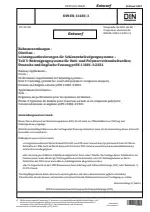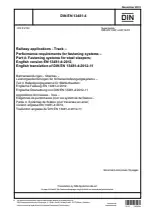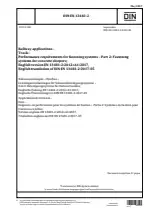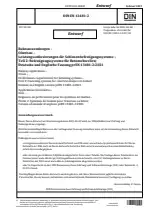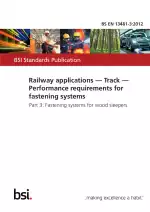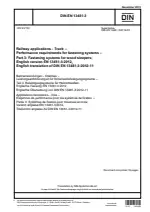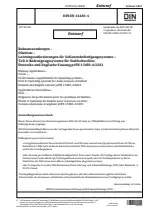Railway Applications - Track - Performance Requirements for Fastening Systems - Part 3: Fastening Systems for Wood and Polymeric Composite Sleepers
Also Known As:
The DIN EN 13481-3 standard specifies the performance requirements for fastening systems to be used on wood or polymeric composite sleepers in ballasted tracks. The standard applies to fastening systems in Categories A-C and E, as specified in EN 13481-1:2012.
The standard defines the maximum axle loads and minimum curve radii for each category, as shown in Table 1. Categories A and B have specified maximum axle loads of 130 kN and 180 kN, respectively, while categories C and E have higher maximum axle loads of 260 kN and 350 kN, respectively. Category D also has a maximum axle load of 260 kN, but is specifically for maintenance vehicles. The minimum curve radii range from 40 m to 400 m, depending on the category.
The requirements of the standard apply to fastening systems that act on the foot and/or web of the rail, including both direct and indirect fastening systems. However, it is important to note that this standard is not applicable to fastening systems used for rail sections other than those specified in EN 13674-1 or EN 13674-4. Additionally, rigid fastening systems and special fastening systems used at bolted joints or glued joints are also not covered by this standard.
It is important to use this standard only for type approval of complete fastening systems.
| Descriptors | Damping, Definitions, Efficiency, Fasteners, Fixings, Performance, Permanent ways, Point work, Proof loading, Rail fastening systems, Railway applications, Railway construction, Railway installations, Railways, Sleepers, Specification (approval), Tracks (materials handling equipment), Travel ways, Turnouts, Type approvals, Vibrations, Vignol rail, Wood, Wooden sleepers, Power, Superstructure, Output capacity, Ties, Sheets, Roadways, Pavements (roads) |
| ICS Codes | 93.100 - Construction of railways |
| Language(s) | English + German |
| File Size | 2.6 MB |

